- 한국어
- English
- 日本語
- 中文
- العربية
- Español
- Français
- Deutsch
- Pусский
- Tiếng Việt
- Indonesian
By Honorary Reporter Karina Gur from Germany
Photos = Karina Gur
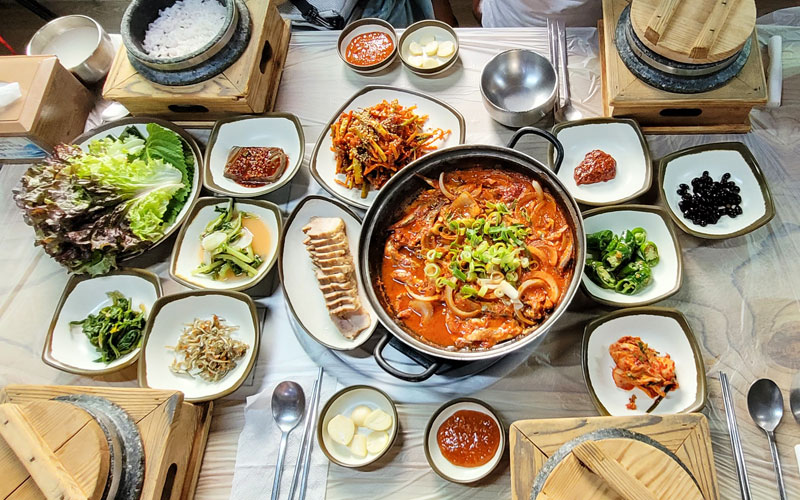
Seafood on Namhaedo Island has a long tradition and is part of the culture of this region.
The picturesque Namhaedo Island on the nation's southern coast is a seafood hub with a huge variety of maritime cuisine. From May 24-26, I visited the island with a group of Honorary Reporters and tried several of these delicacies.
Shaped by a deep connection to the sea and longstanding fishing tradition, Namhaedo has a unique maritime cuisine that is also a crucial aspect of the region's culture and economy.

This picturesque fishing village on Namhaedo Island holds seafood auctions in the morning.
Seafood paradise
Surrounded by the warm waters of the southern sea and protected by impressive mountains, the island provides an ideal environment for sea life while also boasting lush rice fields, green hills and golden beaches.
Fishing plays a central role in the island's economy and culture. Knowledge of fishing and seafood preparation techniques and sustainable use of maritime resources have been passed down from generation to generation. The fish markets there feature a breathtaking diversity of fish, shellfish, crustaceans and seaweed caught from the surrounding waters. From the serving of traditional dishes to festivals, the sea and love of seafood are felt in every aspect of life on the island.
Eco-friendly and sustainable fishing
The island's fishing techniques reflect a deep respect for nature. From traditional nets and traps to specialized equipment like a jukbangnyeom (bamboo fishing weir) and the gathering of shellfish and seaweed during low tide, each method requires skill, knowledge and respect for the sea.

Jukbangnyeom is a bamboo fishing weir for catching anchovies in an eco-friendly way.
The following are the top five seafoods on Namhaedo.
Myeolchi-hoe muchim (seasoned anchovy sashimi)
This dish is one of the most popular traditional foods on the island. Its translation is seasoned anchovy sashimi but it can also be called anchovy salad. Freshly caught anchovies are carefully cleaned and marinated in a mixture of gochujang (red pepper paste), spicy red pepper flakes, sugar, garlic, ginger juice, vinegar, cooking wine and sesame oil. After marinating, the anchovy sashimi is served cold, mixed with fresh vegetables like cucumbers, carrots, spring onions and hot peppers and garnished with sesame seeds. The flavor is a harmonious combination of salty, sweet and spicy as a tasty side dish or light main course.
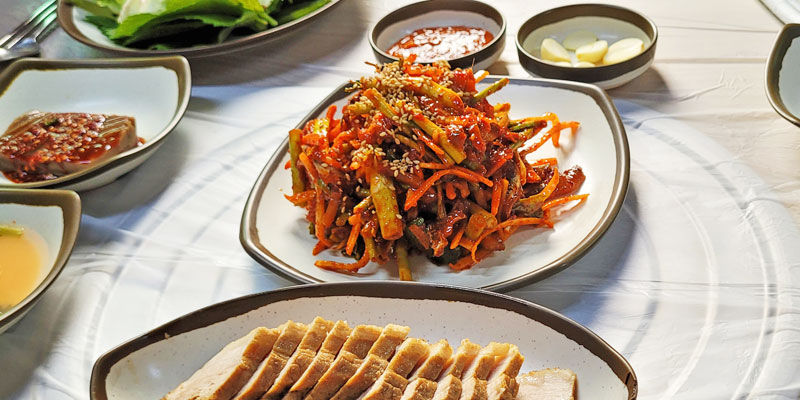
Myeolchi-hoe muchim can be served as a main or side dish.
This was a favorite among the Honorary Reporters group, a seafood version of the classic bibimbap (rice mixed with meat, vegetables and gochujang) featuring the unique flavor and creamy texture of sea urchin roe, fresh flavors of vegetables and seaweed, and cooked rice. One important tip is to not completely mix the roe with the other ingredients but leave it in small pieces. The dish features an explosion of flavors and is an excellent example of how traditional recipes and seafood are creatively combined in Namhaedo cuisine.

Seonggeal (sea urchin roe) bibimbap is a standout dish on Namhaedo Island.
Myeolchi ssambap (anchovy wrap rice)
Small and freshly caught anchovies are cooked in a broth with gochujang, doenjang (soybean paste), onions, garlic, chili and other ingredients. The anchovies are then placed on a layer of freshly cooked rice and wrapped in a crisp lettuce or sesame leaf. Additional ingredients can be added to the wrap like kimchi and other side dishes. The final taste is an interplay of flavor and textural contrasts: the mild anchovy flavor, fresh lettuce and slightly sweet rice. Myeolchi ssambap is also nutritious and healthy.
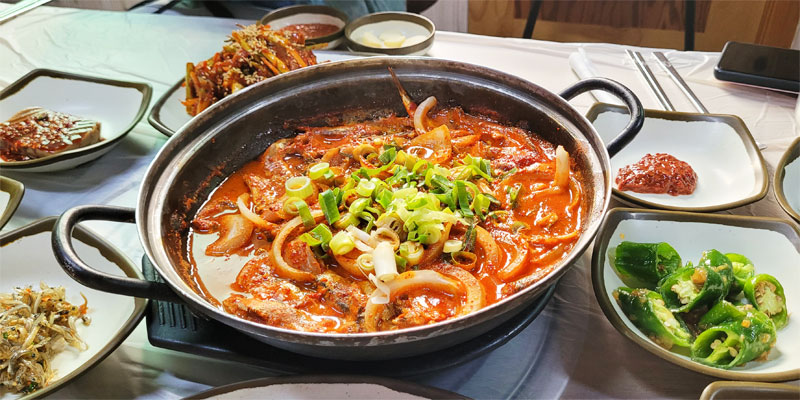
Myeolchi ssambap is often wrapped in a lettuce leaf with other ingredients.
Haechohoe deopbap (seaweed sashimi rice topping)
This dish is made from edible seaweed from the sea. The seaweed is first cleaned and thinly sliced similar to sashimi and later placed raw over a bowl of steaming rice. A light soy sauce, sesame oil or lemon juice is used to enhance flavor. Seasonal sashimi such as flatfish, salmon, tuna and squid cab also be added. This dish is visually appealing with its vibrant colors with a flavor combination of fresh seaweed and mildly smooth rice.
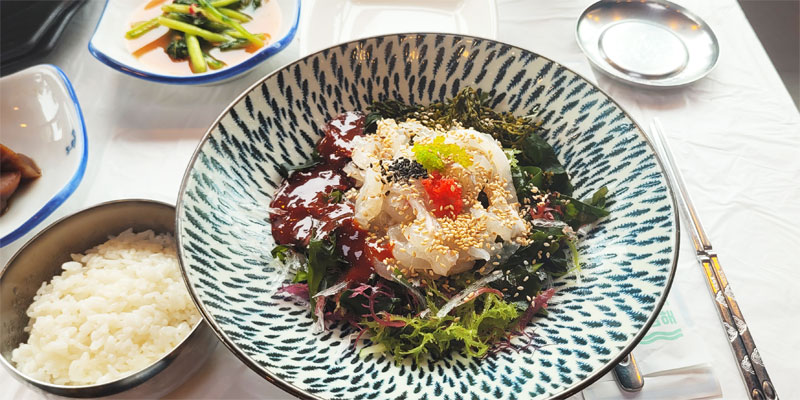
Seasonal raw fish can be used to make haechohoe deopbap.
Another Namhaedo classic, this dish boasts rich flavors and the intense taste of freshly caught swordfish. The fish is cleaned and cut into serving pieces before being slowly simmered in a sauce of soy sauce, garlic, cooking wine and gochugaru (red pepper flakes). The result is a dish slightly sweet and a little spicy, with the sauce enhancing the flavor of the fish without overpowering it. Galchi jorim is cooked with fresh vegetables such as spring onions and potatoes, which absorb the flavors of the sauce during the cooking process.
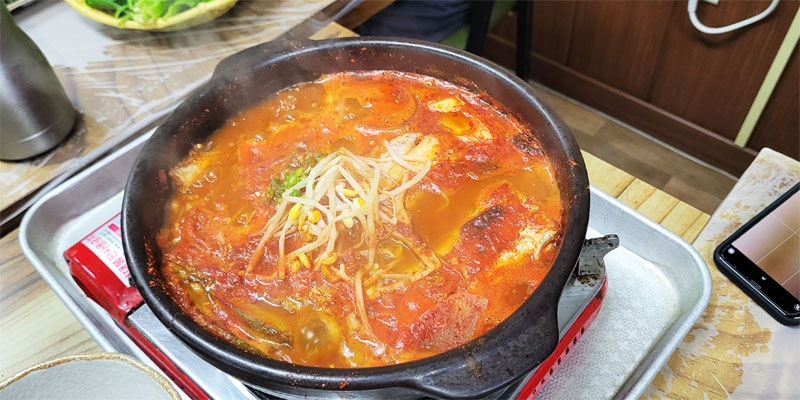
When cooking galchi jorim, the swordfish is cooked in big pieces in the red broth.
msjeon22@korea.kr
*This article is written by a Korea.net Honorary Reporter. Our group of Honorary Reporters are from all around the world, and they share with Korea.net their love and passion for all things.
